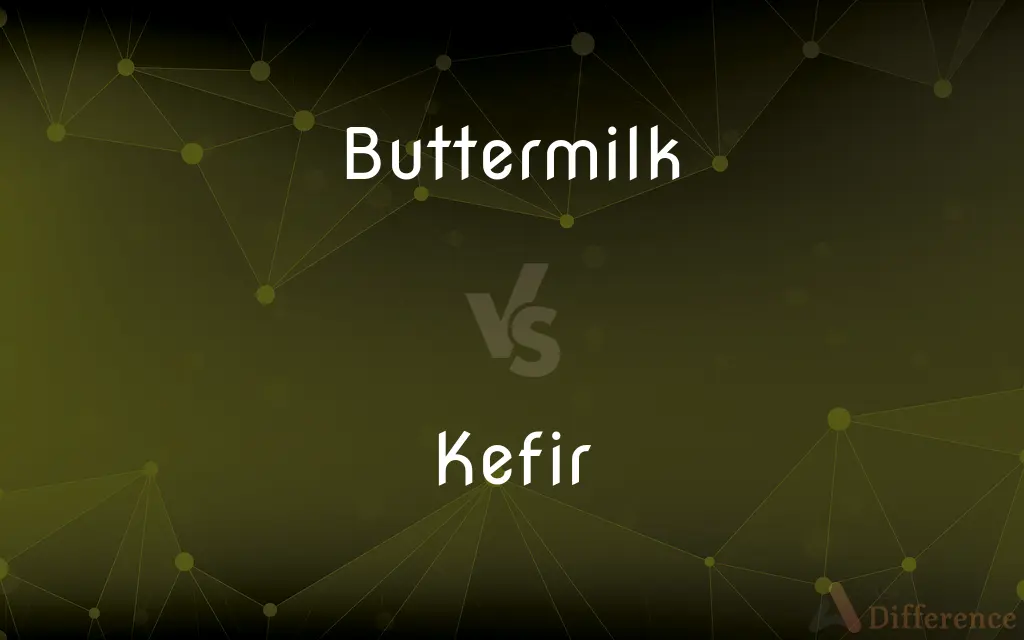Buttermilk vs. Kefir — What's the Difference?
Edited by Tayyaba Rehman — By Maham Liaqat — Updated on March 20, 2024
Buttermilk is a slightly tangy, fermented dairy product, often used in baking, while Kefir is a more potent, probiotic-rich beverage with a tart flavor.

Difference Between Buttermilk and Kefir
Table of Contents
ADVERTISEMENT
Key Differences
Buttermilk traditionally originates from the liquid left after churning butter, whereas Kefir is made by fermenting milk with kefir grains, which contain a larger variety of bacteria and yeasts.
Buttermilk is known for its role in baking, adding a light, tender texture to goods due to its acidic nature, while Kefir is celebrated for its probiotic content, supporting gut health and digestion.
Buttermilk's consistency is similar to that of thin yogurt, making it ideal for pancakes and dressings, whereas Kefir is more drinkable, often consumed on its own for its health benefits.
In culinary contexts, buttermilk can be a crucial ingredient for marinating, especially in Southern cooking, tenderizing meats like chicken, whereas Kefir is used in smoothies, dressings, and sometimes in baking, adding a nutritious boost.
Both buttermilk and Kefir can be used interchangeably in some recipes, but their distinct tastes and textures will influence the final product, with buttermilk being milder and Kefir more tangy.
ADVERTISEMENT
Comparison Chart
Origin
Leftover from butter churning
Fermented with kefir grains
Texture
Similar to thin yogurt
More liquid and drinkable
Taste
Mildly tangy
More tart and tangy
Primary Use
Baking, tenderizing meats
Consumed for probiotics, added to smoothies
Probiotic Content
Lower compared to Kefir
High, with diverse bacteria and yeasts
Compare with Definitions
Buttermilk
A slightly tangy liquid left after churning butter, used in baking.
Buttermilk pancakes are known for their fluffiness.
Kefir
A fermented milk drink made with kefir grains, rich in probiotics.
Kefir is a popular choice for a gut-health boosting breakfast.
Buttermilk
Cultured buttermilk, a fermented dairy product made by adding bacteria to milk.
I used cultured buttermilk in the marinade to tenderize the chicken.
Kefir
Contains a wide variety of beneficial yeasts and bacteria.
The probiotics in kefir include strains not found in other fermented dairy products.
Buttermilk
Often used as a base in creamy dressings and dips.
The salad was dressed with a homemade buttermilk ranch.
Kefir
More liquid and drinkable than yogurt, often consumed on its own.
She enjoyed a glass of kefir every morning for digestive health.
Buttermilk
A traditional ingredient in Southern cuisine, especially in biscuits and fried chicken.
Southern buttermilk biscuits are a family breakfast staple.
Kefir
Sometimes used in baking as a substitute for buttermilk or yogurt.
The recipe called for kefir to make the cake extra moist.
Buttermilk
Can be used as a leavening agent in conjunction with baking soda.
The buttermilk reacted with the baking soda, making the cake rise.
Kefir
Can be used in smoothies and salad dressings for a tangy flavor.
He added kefir to the smoothie for an extra dose of probiotics.
Buttermilk
Buttermilk is a fermented dairy drink. Traditionally, it was the liquid left behind after churning butter out of cultured cream; however, as most modern butter is made not with cultured cream, but with sweet cream, most modern buttermilk is cultured.
Kefir
Kefir (also spelled as kephir or kefier, Russian: Кефир; Karachay-Balkar: Гыпы) ( KE-feer), is a fermented milk drink similar to a thin yogurt or ayran that is made from kefir grains, a specific type of mesophilic symbiotic culture. The drink originated in the North Caucasus, in particular the Elbrus environs along the upper mountainous regions of Karachay and Balkaria from where it came to Russia, and from there it spread to Europe and the United States, where it is prepared by inoculating the milk of cows, goats, or sheep with kefir grains.
Buttermilk
The liquid, usually either naturally soured or cultured with acid-producing bacteria, that remains after the butterfat has been removed from cream by churning.
Kefir
A creamy drink made of fermented cow's milk.
Buttermilk
A sour milk made by culturing usually skim milk with acid-producing bacteria.
Kefir
A fermented milk drink from the Caucasus and Eastern Europe, similar to yogurt but more liquidy.
Buttermilk
The liquid left over after producing butter from full cream milk by the churning process, also called traditional buttermilk.
Kefir
An effervescent liquor like kumiss, made from fermented milk, used as a food and as a medicine in the northern Caucasus.
Buttermilk
Cultured buttermilk, a fermented dairy product produced from cow's milk, with a characteristically sour taste.
Kefir
A sour fermented milk drink, used in various regions of Asia, made by addition of Streptococcus or Lactobacillus cultures to cow's or goat's milk; it is considered by some as a form of yoghurt.
Buttermilk
The milk that remains after the butter is separated from the cream.
Buttermilk
Residue from making butter from sour raw milk; or pasteurized milk curdled by adding a culture
Common Curiosities
Can buttermilk be used for health purposes like Kefir?
While buttermilk contains some probiotics and nutrients, Kefir is more recognized for its health benefits, particularly for digestive health.
What is the main difference between buttermilk and Kefir?
Buttermilk is a by-product of butter making with a mildly tangy taste, while Kefir is a fermented milk drink rich in probiotics with a more robust tartness.
Is buttermilk or Kefir better for baking?
Buttermilk is traditionally preferred for its leavening properties in baking, though Kefir can also be used, especially for its nutritional value.
Can I substitute Kefir for buttermilk in recipes?
Yes, Kefir can substitute for buttermilk in most recipes, but expect a tangier taste and thinner consistency.
Is buttermilk or Kefir better for lactose-intolerant individuals?
Kefir is generally better tolerated by those with lactose intolerance due to its fermentation process, which reduces lactose content.
How do I make buttermilk at home?
You can make a buttermilk substitute by adding an acid, like lemon juice or vinegar, to milk and letting it sit for a few minutes.
How do I make Kefir at home?
Homemade Kefir requires kefir grains and milk; the mixture is left to ferment at room temperature for 24-48 hours.
Is buttermilk used in any cuisines outside of American, particularly Southern?
Yes, buttermilk is used in various international cuisines, including Indian, where it is consumed as a drink or used in recipes.
Which has more probiotics, buttermilk or Kefir?
Kefir contains a broader range and higher concentration of probiotics than buttermilk.
Are there non-dairy alternatives for buttermilk and Kefir?
Yes, there are non-dairy versions of both, made from alternatives like coconut, almond, and soy.
How should buttermilk and Kefir be stored?
Both should be refrigerated and tightly sealed to maintain freshness.
How long do buttermilk and Kefir last once opened?
Typically, buttermilk lasts about 2 weeks, while Kefir can last up to a month in the refrigerator.
What are the nutritional differences between buttermilk and Kefir?
Kefir generally has more protein and probiotics compared to buttermilk, which is lower in fat and calories.
Can I use buttermilk and Kefir interchangeably in marinades?
Yes, both can tenderize meats in marinades, though Kefir might impart a stronger flavor.
Are there flavored versions of Kefir?
Yes, Kefir is available in various flavors, including fruit-flavored varieties.
Share Your Discovery

Previous Comparison
Hair vs. Fur
Next Comparison
Row vs. LineAuthor Spotlight
Written by
Maham LiaqatEdited by
Tayyaba RehmanTayyaba Rehman is a distinguished writer, currently serving as a primary contributor to askdifference.com. As a researcher in semantics and etymology, Tayyaba's passion for the complexity of languages and their distinctions has found a perfect home on the platform. Tayyaba delves into the intricacies of language, distinguishing between commonly confused words and phrases, thereby providing clarity for readers worldwide.














































